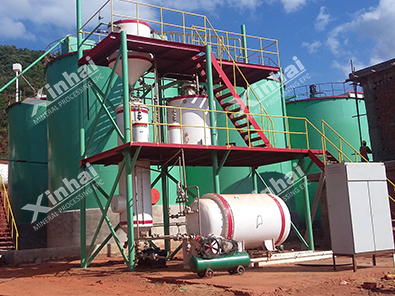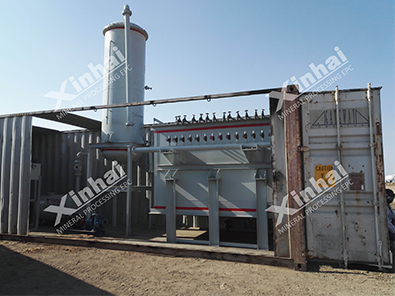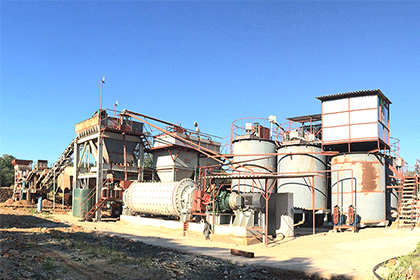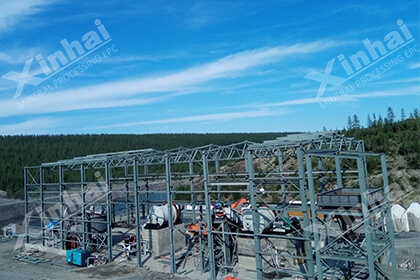Leaching Process | What are Methods of Cyanidation Gold Extraction Process
 Laura
Laura
 Jun 21, 2022
Jun 21, 2022
 1149
1149
If you want to know more details about equipment, solutions, etc, please click the button below for free consultation, or leave your requirements!

(Gold processing project 1.2 million tpa in Mongolia Stapen)
01What is Cyanidation Gold Extraction Process?
BackGold extraction by cyanidation is a method of leaching gold from gold-containing ore with an aqueous solution of cyanide as a solvent, and then extracting gold from the gold-containing leaching solution. In addition, the gold extraction by cyanidation mainly includes the following two steps:
1. Cyanide Leaching
In a dilute cyanide solution and in the presence of oxygen (or oxidant), gold in gold-bearing ore reacts with cyanide to form a monovalent gold complex that dissolves into the solution, Taking potassium cyanide as an example to obtain the leachate, the reaction formula is:
4Au+8KCN+2H2O→4KAu(CN)2+4KOH
There are two types of cyanide leaching methods for gold leaching: tank leaching cyanide method and heap leaching cyanide method. The tank leaching cyanidation method is a traditional gold leaching method, which is divided into two types: the percolation cyanidation method and the stirring cyanidation method;
Since it was discovered that cyanide solution can dissolve gold in 1887, cyanide leaching has been in production practice for nearly a hundred years. The process is relatively mature, the recovery rate is high, the adaptability to ore is strong, and gold can be produced in situ, so it is still gold leaching production. main method.
2. Deposition Gold Extraction
Gold extraction from cyanide leaching solution. The process methods include zinc replacement method (zinc wire replacement method and zinc powder replacement method), activated carbon adsorption method (carbon pulp method CIP and carbon leaching method CIL), ion exchange resin method (resin pulp method RIP and RIL), electrolytic deposition method , magnetic carbon method, etc. Zinc powder (silk) replacement method is a more traditional gold extraction method, which is widely used in gold mines; carbon slurry method is currently the preferred method for new gold mines, and its gold production accounts for more than 50% of the world's gold production; other methods It is also being used in gold mines.
02What are Methods of Cyanidation Gold Extraction Process?
Back1. Percolation Cyanidation Method
The percolation cyanidation method is one of the technological methods of cyanidation leaching. It is a method based on the penetration of cyanide solution through the ore layer to leaching gold in gold-bearing ores. It is suitable for placer and loose porous materials.
The main equipment of the percolation cyanation method is the percolation leaching tank. The percolation leaching tank is usually a wooden tank, an iron tank or a cement tank. The bottom of the groove is horizontal or slightly inclined, and it is round, rectangular or square. The diameter or side length of the groove is generally 5~12 meters, the height is generally 2~2.5 meters, and the volume is generally 50~150 tons.
The process of percolation cyanidation methods:
#1. Loading ore sand and alkali: uniform cloth, uniform particle size and uniform looseness are required. There are dry and wet methods. The dry method is suitable for ore with moisture below 20%, and can be loaded manually or mechanically. The wet method is to dilute the pulp with water, then lift it with a sand pump or flow it into the tank along the tank.
#2. Percolation and leaching: After the loading is completed, the cyanide solution can be sent into the tank. There are two flow directions of the cyanide solution in the tank: one is top in and bottom out. That is, the cyanide liquid is injected from the top of the tank and passes through the ore sand layer from top to bottom under the action of gravity; After the leaching is completed, the cyanide tailings are washed with water.
#3. Tailings discharge: There are dry and wet methods. The dry method discharges the cyanide tailings through the working door at the bottom of the tank; the wet method is to wash the cyanide tailings with high pressure water, so that the tailings slurry flows out along the pre-arranged tailings pipe (trough).
2. Stirring Cyanidation Method
The stirring cyanidation method is one of the technological methods of cyanidation leaching. The slurry obtained after grinding and classifying gold-containing ore is concentrated to a suitable concentration, placed in a leaching tank, added with cyanide solution, and aerated and stirred for leaching. This method is suitable for materials with particle size less than 0.3~0.4 mm.
The main equipment of the stirring cyanidation leaching method is the cyanide leaching tank. According to the different stirring methods, cyanidation leaching tanks are divided into three types:
#1. Mechanical stirring leaching tank is the leaching tank commonly used in gold processing plants.
#2. Air-stirred leaching tank uses the pneumatic action of compressed air to agitate the pulp. The most commonly used is the Bachuk leaching tank.
#3. Air-mechanical combined agitation leaching tank is a combination of the above two tanks, and has both effective mechanical and air agitation devices. The main advantage is the fast dissolution rate of gold.
After the stirring cyanide leaching is completed, the gold-containing solution needs to be separated from the pulp by a washing method. There are three washing methods:
One is the decantation method: batch method and continuous method. The former is rarely used due to the disadvantages of long operation time and large amount of solution used. The continuous decantation method is washed according to the countercurrent principle, that is, the pulp is fed into the concentration tank from front to back, and the washing liquid is returned from the back to the front, so that the washing liquid used for each concentration of the pulp is used in the next concentration. flow. This washing method can be realized by connecting several single-layer concentrators or multi-layer concentrators in series.
The second is the filtration method: use a filter to complete the separation and washing operations. This is usually done with a continuous vacuum filter.
The third is the fluidization method: the washing process is completed in the washing column. At present, this method is in the experimental stage along the gold processing plant in my country.
3. Heap Leaching Cyanidation Method
Heap leaching cyanidation method, also known as heap leaching method and heap leaching method, is one of the technological methods of cyanidation leaching, which is mainly used for processing low-grade gold ore. In 1971, the world's first industrial-scale gold heap leaching plant was put into operation in Nevada, USA, and has now developed into a mature process.
The heap leaching cyanidation method is to crush or agglomerate the gold-containing low-grade ore into lumps of 3-10 mm, which are stacked on the anti-seepage bottom pad, and sprayed from the top of the ore heap with cyanide liquid to dissolve the gold in the ore. , the precious liquid containing gold percolates out from the ore heap and flows into the precious liquid pool. The gold-containing precious liquid obtained by heap leaching can be used to recover gold by metal zinc replacement method, activated carbon adsorption method, etc., and the recovered lean liquid is returned to the heap leaching operation for recycling.
The heap leaching cyanidation method has low production cost and can be put into operation quickly. The heap leaching scale can be large or small, and each heap of ore can reach tens of thousands of tons. In the United States, each heap of 10,000 tons of ore is a standard heap; the grade is less than 0.6 g/ The ton of rock wool is generally heap leached without crushing, and the ore of 0.6~1.0 g/ton is crushed to a certain particle size and then heap leached.
4. Zinc Wire Replacement Method
The basic principle of the zinc ratio replacement method is that zinc interacts with the gold-containing cyanide leaching solution, and gold is replaced by zinc and is converted into a metal state and precipitated: 2Au(CN)2-+Zn ==== 2Au+Zn(CN)42-
The zinc wire replacement method is carried out in a zinc wire replacement sedimentation box (commonly known as a gold cabinet). Zinc wire replacement sedimentation box is an open rectangular box made of wood, steel or cement. The box is 3.5~7 meters long, 0.45~1 meters wide, and 0.75~0.9 meters deep. The box is divided into several (5~20) cells by horizontal partitions, and there is also a partition in each cell. The first grid is generally used to clarify the gold-containing solution and add cyanide (to increase the cyanide concentration of the solution); the last grid is used for the gold mud taken away by the solution; the remaining grids are placed with 6-12 mesh screens The iron frame, and the screen is equipped with zinc wire. This structure is to allow the gold-containing solution to flow from front to back into each cell containing zinc wires. The handle is fixed on the screen. It is necessary to gently lift up and down periodically to loosen the zinc wire and make the gold mud separate from the zinc wire and deposit on the bottom of the box. Gold mud is generally discharged 1 to 2 times a month, and the discharge port is usually blocked with a wooden box. Gold mud is the raw material for smelting.
The zinc wire replacement method is a traditional method for extracting gold from a gold-containing cyanide solution and has been industrially applied as early as 1888. This method consumes a large amount of zinc wire and NaCN, and the obtained gold mud contains high zinc content and occupies a large area. It has been basically replaced by the widely used zinc powder replacement method. However, the method is simple to operate, does not consume power and the box is easy to manufacture, so it is still used in some small gold mines and local gold mining in my country.
5. Zinc Powder Replacement Method
Zinc powder replacement method is to mix zinc powder with gold-containing solution, gold is replaced by zinc and then precipitate, and then filtered, gold powder and excess zinc powder enter the filter cake (ie, cyanide gold mud), and are separated from the liquid after gold removal. The basic principle is the same as the zinc wire replacement method. Since the surface area per unit weight of zinc powder is much larger than that of zinc wire, the efficiency of zinc powder replacement method is much greater than that of zinc wire replacement method.
In production practice, the gold-containing solution is usually deoxygenated by a deoxygenation tower before displacement precipitation.
Equipment contact for zinc dust replacement. The zinc powder and the gold-containing deoxidizing solution are fed into the mixing tank for mixing, and then the zinc powder replaces the precipitator for precipitation and filtration through the self-flowing tube at the bottom of the tank. The filter cloth is discharged through the branch pipe and the main pipe. The discharge of gold mud is an intermittent march, and 2 to 3 replacement precipitators are required for continuous replacement and sedimentation.
Zinc powder is obtained by rapidly cooling zinc vapor in a large-volume condenser by the method of sublimation. The particle size is less than 0.01 mm, which is easy to be oxidized, so it must be strictly sealed during transportation or storage.
6. Carbon in Pulp Method
Carbon in Pulp (CIP for short) is a new process for recovering gold by adsorption with activated carbon from the pulp leached by cyanidation. In 1973, the world's first industrialized CIP plant was put into operation at the Holmstark Gold Mine in the United States, and it was quickly extended to countries around the world. Its technological process is:
#1. Pretreatment: Cyanide pulp should be screened to remove coarse particles (such as sand) and sawdust before adsorption, so as to prevent these impurities from affecting the adsorption and separation of gold-loaded activated carbon and de-gold pulp, and to avoid accelerated wear of activated carbon and de-gold Activated carbon is difficult to regenerate; activated carbon should also be pre-ground to remove sharp corners and edges before entering the adsorption tank. Without pre-grinding, these chips will enter the de-gold slurry and cause gold loss.
#2. Adsorption: Activated carbon is added to the fully leached pulp, and the activated carbon adsorbs the gold in the cyanide pulp to become gold-loaded carbon. Adsorption is carried out in an adsorption tank (carbon slurry tank). There are many kinds of adsorption tanks. For the slurry with fine mud, the ordinary Dole-type tank with low-speed central stirring should be used; for the slurry with coarse particle size, the Bachuk air stirring tank should be used. Adsorption tanks are used in series in production. After the adsorption is completed, the gold-loaded activated carbon and the de-gold pulp are separated by the screen installed on the carbon slurry tank.
#3. Desorption: The gold-loaded carbon separated from the de-gold pulp is called desorption. Commonly used desorption methods include atmospheric pressure desorption and pressure desorption. Desorption is carried out in a desorption column. The gold-loaded carbon washed with clean water is loaded into the desorption column, and then the carbon layer is immersed in 4% NaCN and 2% NaOH aqueous solution, and heated to 90 ℃ ~ under normal or pressurized conditions. At 95°C, the gold was washed with water after 2~4 hours, and the total desorption time was 12~24 hours. After desorption, gold-rich desorption liquid and desorption carbon are obtained.
#4. Immersion Gold: Recovery of gold from gold-rich desorbent. The method of depositing gold from the desorption solution is mainly electrowinning.
#5. Regeneration and activation of desorption carbon: After regeneration, the desorbed desorbed carbon is added to new activated carbon in proportion and reused in the process.
The activated carbon used in the production of gold today is mostly coconut shell carbon in foreign countries and apricot kernel carbon in China. When choosing to use activated carbon, the strength (that is, wear resistance), adsorption capacity, desorption and regeneration performance, selectivity and price of activated carbon should be considered, among which strength is the most important.
The carbon slurry method is mainly suitable for gold-bearing oxidized ores with high sludge content. Since the 1980s, my country has carried out research on the carbon slurry method. More than 20 carbon-pulp gold extraction plants have been built in Henan Linghu Gold Mine and Jilin Chiweigou Gold Mine.
7. Carbon Leaching Method
Carbon leaching (Carbon in Leach, CIL for short) is a new gold extraction process that combines cyanidation leaching and activated carbon adsorption to recover gold at the same time. It has the same principle as the carbon slurry method, the difference is that the carbon slurry method is to add activated carbon to adsorb gold after the leaching is completed. The carbon leaching method is to add activated carbon to the leaching tank, and cyanide leaching and carbon adsorption are carried out in the same tank.
8. Lon Exchange Resin Method
The ion exchange resin method is a method of using ion exchange resin to adsorb and recover gold from cyanide pulp. There are two gold extraction methods: RIP and RIL. RIP is called resin pulp method, which is leaching first and then adsorption. It has been used for many years in the former Soviet Union, and only the Jolden Jubilee gold mine in South Africa has adopted it in the Western world. RIL is adsorption while leaching, and it is said that there is no example of industrial application. Some people also refer to RIP and RIL collectively as resin pulp method.
The principle of the ion exchange resin method is that the ion exchange resin can dissociate two ionized groups in the solution: the fixed ion (R) that cannot be ion exchanged and the exchangeable ion that is opposite to the fixed ion. According to the positive and negative charges of the exchangeable ions, ion exchange resins are divided into cation exchange resins and anion exchange resins. In cyanide pulp, gold exists in the form of anion complex Au(CN), so when using ion exchange resin method to extract gold, anion exchange resin must be used. The ion exchange reaction of extracting gold from cyanide solution with ion exchange resin is: R-OH+Au(CN)2- ==== R-Au(CN)2+OH-
The basic process of gold extraction by resin pulp method is:
#1. Adsorption: When the gold-containing cyanide solution passes through the exchange resin column, an ion exchange reaction occurs, and gold is adsorbed on the resin.
#2. Desorption: The gold on the resin is desorbed into the solution with a desorbent. For weakly basic gold-loaded resin, it can be desorbed with sodium hydroxide solution with pH=13 at normal temperature and pressure; Cyanide complex method desorption.
#3. Recovery of gold: gold is recovered from the desorption solution rich in gold by zinc powder replacement method, lye precipitation method or electrolysis method.
The ion exchange resins currently used to adsorb gold from cyanide liquid are: strong basic anion exchange resin AM, AB-17, weak basic ion exchange resin 704, mixed basic ion exchange resin AM-2B, A-2 etc. The AM-2B was widely used in the production of the former Soviet Union. AM-2B is a bifunctional resin with macroporous structure, which has better selectivity, mechanical strength, adsorption and desorption properties than other resins.
9. Electrowinning
Electrowinning is a method of directly extracting gold from a gold-containing cyanide solution under the action of a DC electric field.
Electrowinning generally uses 2 to 3 electrolytic cells in series. Electrolyzers are rectangular and made of plastic or fiberglass. Stainless steel drilled steel plate is used as anode, and stainless steel cotton is used as cathode. The gold-containing cyanide solution is placed in the electrolytic cell. During electrolytic deposition, gold and silver are deposited on the cathode, and the electrode reaction is as follows:
Cathode: Au(CN)2-+e —— Au+2CN-
2H++e —— H2
Anode: CN-+2OH- —— CNO-+H2O+2e
2CNO-+4OH- —— 2CO2+N2+H2O+6e
4OH- —— 2H2O+O2+4e
When the amount of gold deposited on the cathode reaches 5 to 10 times the weight of the cathode steel wool, take out the cathode in the first electrolytic cell, place the cathode in the second cell in the first cell, and put a new cathode into the first cell. In the second tank, the electrodeposition operation is carried out in this way. Remove the deposited gold (gold-containing steel wool) from the cathode taken out of the first tank, and use hot hydrochloric acid to dissolve part (mainly Fe), and then smelt to obtain a gold-silver alloy.
The main factors affecting the electrowinning process are: the concentration of gold in the electrolyte, the concentration of sodium hydroxide in the electrolyte, the feeding speed of the electrolytic cell, the surface area of the cathode, the stirring of the electrolyte, the cell voltage, and the temperature of the electrolyte.
10. Magnetic Carbon Method
The magnetic carbon method is a new process method developed on the basis of improving the carbon slurry method. Different from the carbon slurry method, the magnetic carbon method uses magnetic activated carbon to adsorb gold, and a magnetic separator is used to separate the pulp and carbon; while the carbon slurry method uses ordinary activated carbon to adsorb gold, and uses a fine sieve to separate the pulp and carbon.
Magnetic activated carbon is made by bonding finely ground magnet powder and carbon together with sodium silicate as a binder, and then drying and activating it. The abrasion resistance of magnetic activated carbon is better than that of ordinary activated carbon.
03Summary
BackThe above are 10 main process methods of gold extraction by cyanidation. In the actual beneficiation process, we need to combine the characteristics of the ore and other interference factors to comprehensively select the appropriate gold extraction process.
 +86 18716000713
+86 18716000713 xlyin@xinhaimining.net
xlyin@xinhaimining.net




 Message
Message Chat Now
Chat Now



















